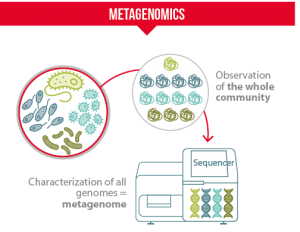
Metagenomics is a field of genomics that studies the genetic material (DNA and RNA) of entire communities of microorganisms, including bacteria, viruses, fungi, and parasites, rather than focusing on a single species or organism. This approach allows researchers to understand the collective genetic diversity and functional potential of these communities and how they interact with their environment. The field of metagenomics has revolutionized our understanding of the microbial world, including the human microbiome and other ecosystems. It has a wide range of applications, including environmental monitoring, disease diagnosis and treatment, biotechnology, and bioremediation.
There are two main types of metagenomics:
- Shotgun Metagenomics: This approach involves randomly sequencing the entire DNA or RNA from a sample, regardless of its source, followed by computational analysis to identify and characterize the different species present in the sample. Shotgun metagenomics provides a comprehensive view of the genetic diversity within a sample and is particularly useful for characterizing complex microbial communities.
- Targeted Metagenomics: This approach involves sequencing specific genes or regions of interest within a sample, such as the 16S ribosomal RNA gene in bacteria, to identify the presence of specific groups of microorganisms. Targeted metagenomics is useful for studying specific taxa or functional groups within a sample, and is often used to compare the composition of different samples.
Both shotgun and targeted metagenomics have their own advantages and disadvantages, and the choice of approach often depends on the research question being addressed and the resources available. Additionally, both approaches can be combined to obtain a more comprehensive understanding of a microbial community.
Here are some recent trends in the field of metagenomics:
- Increased use of single-cell sequencing: With the advancement of single-cell sequencing technologies, metagenomics is becoming more precise and efficient in characterizing the genetic content of individual cells within a community. This is especially important in understanding the functional diversity and roles of rare or uncultured microorganisms.
- Development of metagenome-assembled genomes (MAGs): MAGs are complete genomic sequences reconstructed from metagenomic data, which provide a more comprehensive view of the functional potential and ecological roles of microbial communities.
- Advancements in metagenomic data analysis: The development of new bioinformatics tools and pipelines has made it easier to analyze large amounts of metagenomic data, allowing for more accurate and faster interpretation of results.
- Expansion into non-microbial communities: The field of metagenomics is expanding to include the study of other types of communities, such as plant, animal, and insect communities, and the viruses that infect them.
- Integration of multi-omics data: The integration of multiple types of omics data, such as transcriptomics, proteomics, and metabolomics, provides a more comprehensive understanding of the functional and metabolic interactions within microbial communities.
- Increasing applications in medicine and biotechnology: Metagenomics is playing a growing role in personalized medicine, enabling the identification of pathogenic microorganisms and the development of novel therapies based on the understanding of the human microbiome. Additionally, metagenomics is being used in biotechnology to identify novel enzymes and metabolic pathways that can be used in industrial applications.
Here are some of the major companies in the field of metagenomics:
- Illumina: A leading provider of sequencing technologies and genomic services, Illumina offers a range of metagenomics solutions, including its HiSeq and MiSeq platforms.
- Qiagen: A provider of sample and assay technologies, Qiagen offers metagenomics solutions for both research and clinical applications, including its QIIME2 and Ingenuity Pathway Analysis software.
- Thermo Fisher Scientific: A leading provider of scientific instruments and reagents, Thermo Fisher offers a range of metagenomics solutions, including its Ion Torrent and Illumina sequencing platforms.
- Roche: A global leader in pharmaceuticals and diagnostics, Roche offers a range of metagenomics solutions through its 454 and Illumina sequencing platforms.
- BGI: A global leader in genomic research, BGI offers metagenomics solutions through its BGISEQ-500 and HiSeq platforms, as well as its cloud-based bioinformatics platform, BGI Cloud.
- Novogene: A provider of genomics and bioinformatics services, Novogene offers metagenomics solutions through its Illumina sequencing platforms and its proprietary bioinformatics pipelines.
- Agilent Technologies: A provider of life sciences and analytical instruments, Agilent offers metagenomics solutions through its SureSelect Target Enrichment and NextSeq platforms.
- Fudan University Shanghai Medical College: A leading provider of genomic services in China, Fudan University offers metagenomics solutions through its high-throughput sequencing platforms and its bioinformatics pipelines.

